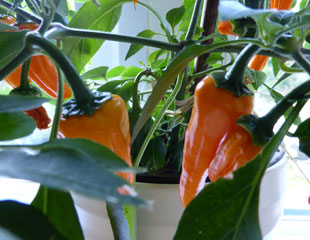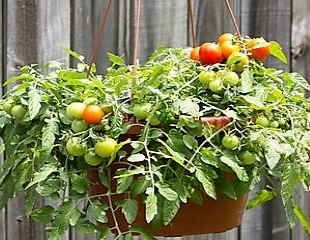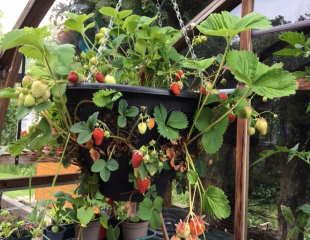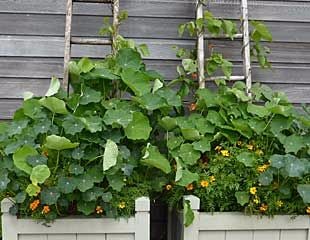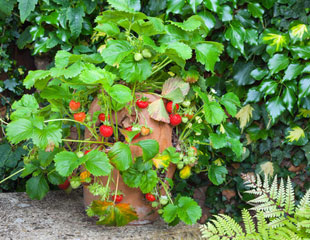
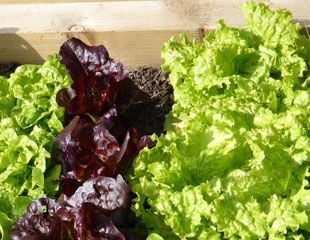
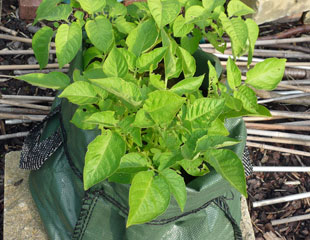
10 Best Veg for Growing in Containers
You do not need a large garden, a dedicated veg plot, or an allotment to grow veg. Many vegs will grow well in containers. Even with limited space, you can enjoy tasty, healthy home-grown vegetables. Better still is the enjoyment of eating your own veg. I don't know why it makes me smile, but it does.
The trick is to pick vegetables which are best suited and easiest to grow in containers. The challenge with container-grown vegetables is to get enough food and water into the container over the growing season to ensure a good tasty crop.
Bear in mind most vegetables need full sun, so if you have a balcony which may be subject to some shade, you need to take this into account. No vegetables will grow in full shade but there are some which will tolerate some shade: Kale, Lettuce and rocket, carrots and leeks.
Top of the veg list for containers are tomato, cucumber, compact varieties of courgette, potatoes, strawberries, garlic, chillies, lettuces, rocket, salad crops and herbs which will all grow in containers.
Vegetables which are not so easy in containers are all the beans: Broad, Runner, French, Peas, larger courgettes and squashes, Main Crop potatoes, Brassicas, Onions, Sweetcorn and Artichokes. These crops are large, and it's hard to get enough plants to make a decent crop. You buy some dwarf versions of Peas and beans to try.
Container size does matter

Before planting any veg, think about the pot size and especially the ulitmate pot size after potting on where the veg will grow for the rest of the season.
This image demonstrates the effect of growing plants, in this case Chillies, in different sized pots. And it results in different sized plants.
I planted the chillies in the long brown planter from the containers in front of the respective plants. All seeded and grown together. You will see that the largest plant, left, was grown in the largest container and at the end, the smallest plant was repotted from the smaller container.
You cannot put a small plant, whether chilli or any other veg, straight into a large pot; it will not thrive. But you can pot it on into large pots and ensure that the final container, for the rest of the growing season, is a good size if you want a really good plant and crop.
Top tips for growing veg in containers:

Grow your crop in the largest pot you have and do not plant up too densely. It is tempting to pack more plants in, but it's a law of diminishing returns as the crop gets smaller. Too much competition.
Fill the pot with good quality compost and organic material to hold the moisture.
Watch out for top heavy pots. Summers can be windy with gusty storms, and an unbalanced container can get dislodged. I took the image left in my garden this year 2025. It is best to weight the container down. You can even lay a brick on the surface if it's a single stem plant such as tomatoes.
Mulch the top to reduce water loss by evaporation.
On warm sunny days, it may be necessary to water container grown veg once/twice daily, which can be time consuming and uses a precious resource. Using grey water on vegetables in not recommended, especially in containers because of a buildup of residual chemicals. There are ways to water wisely read more.
Many people recommend using water retaining gel as an option in container gardening. Personally, I do not think this is compatible with growing vegetables because of its chemical components.
The better option will be plenty of organic matter to hold water and a mulch to reduce evaporation,
The 10 Best Veg to Grow in Containers
Rocket
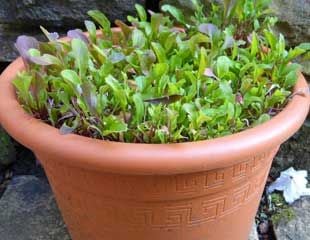
Rocket is ideal for growing in containers. Sow evenly into the container, quite close to the surface, and sprinkle lightly with compost. Keep your eye on it and do not let it dry out. I usually mist or lightly water the compost before sowing.
As the name suggests, Rocket is a quick crop to harvest. There should be baby leaves to cut after about 3 weeks and a more mature crop at around 6 weeks, depending on the weather. Many varieties do well as cut and come again, and at the end of the season you can harvest the seeds for next year. Tips on growing Rocket.
Lettuce
All varieties of lettuce will grow well in containers, especially Little Gem varieties, cut and come again salad crops, micro leaves, cress and radishes. Slugs are keen on lettuces and the containers will need slug protection. You can grow a decent crop of different lettuces in containers, much fresher and more satisfying than bagged leaves from the supermarkets.
Cucumber

Cucumbers are a surprisingly rewarding crop. Home-grown cucumbers are crunchy and juicy, a superior veg to those retailing in supermarkets. You can grow cucumbers in a greenhouse, or outside. The important thing is to select the right variety for each. There are cucumber varieties solely suitable for inside or outside growing, and the packet will tell you. Growing cucumbers in a container will need a support to accommodate the upright growth, and they will need to be well watered.
Chillies
Chillies make a great pot plant and because they need a good amount of warmth, Chillies often crop best grown indoors under cover. In the kitchen, on a sunny windowsill, is an option.
Chillies need a long growing season and are best germinated late in February or early March. Sow 2/3 seeds to a small container and keep warm and moist. Once the true leaves appear and the seedlings are sturdy enough, pot up into larger containers and grow on. Chillies are easy to grow.
Potatoes
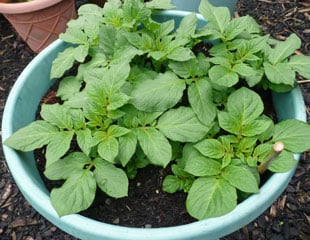
First earlies and salad potatoes are suitable to growing in containers. Choose a good-sized container with drainage holes, potatoes dislike being water logged. Fill the container with quality compost and firm down. Add just 2/3 tubers per container depending on the size of the pot and cover tubers with a thick layer of compost about 20cms. Raise the container off the ground to protect against frost and aids drainage. Protect new top growth from frost.
As new growth comes through earth up in the pot, carefully covering the new growth, taking great care not to damage the stems. Potatoes are ready to harvest once the flowering starts and after flowering.
Tomatoes
All varieties of tomatoes are suitable to grow in containers. If you are growing in hanging baskets the small cherry types do best. In the UK tomatoes are often containers in a sheltered spot.
Homegrown tomatoes are tasty, but time-consuming to grow. For the best tips on how to get a good crop, checkout growing tomatoes for important advice on watering and feeding. Tomatoes start off in small containers and need to be potted on to a larger container and then finally into the biggest container in which they will grow for the rest of the season. Detailed growing advice and short video about the importance of removing side shoots.
The easiest types of tomatoes for containers are the bush types such as tumbling tom, Sungold which can even be grown in a hanging basket.
Growing Garlic
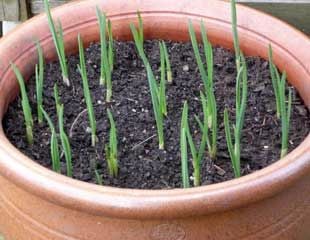
Onions need too much space to be suitable for growing in containers, but garlic is ideal and easy to grow.
Place a few cloves in a suitable pot, plant about twice the depth of the clove, cover with compost, water and put in a sunny position. You can plant Garlic into containers in autumn or spring, just check the suitability of the type of garlic you purchase. In the image there are to many plants which will need to be thinned out and replanted in another container so they are all spaced further apart.
A bonus is that Garlic stores really well and you can keep it for months over the autumn and winter after harvesting more information on growing garlic.
Strawberries in a hanging basket
Strawberries grow in well in a hanging basket or container, and even if grown in a greenhouse, the pollinators will do their business and there will be plenty of fruit.
The advantage of growing strawberries in a hanging basket is that you do not need to net them to protect from the birds, or use straw to avoid dirt splashes. The downside is they need regular watering. This You Tube Video includes tips about growing Strawberries in containers.
Had I been more organised when I planted this, I would have included some Nasturtium for extra colour and interest, a thought for next year.
Herbs
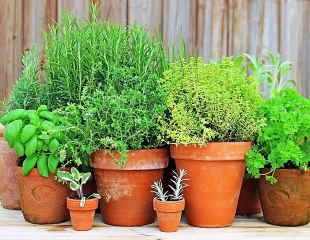
Herbs are ideal container plants, either in separate containers or several planted together. You can have a herb garden with out having a garden.
If planting several herbs together, they need to be tolerant of similar growing conditions. Thus, Rosemary, Thyme and Sage will grow well together. Mint is best in a container of its own and some herbs like it more moist and even a tad shady, such as parsley and coriander.
Tips about growing herbs and herbs for shade.
Also, a video on how to create a cheap and easy herb garden no green fingers required.
Dwarf peas and beans
In the main, most beans and peas are too tall and we need too many plants for a decent crop. However, the dwarf varieties of peas and beans grow well in containers, although they may need some slug protection.
This illustration shows how vegetables in containers can be combined with annuals for an interesting display. Illustrated is marigold, Nasturtium and climbing up at the back are beans, an image taken at RHS Harlow Carr

